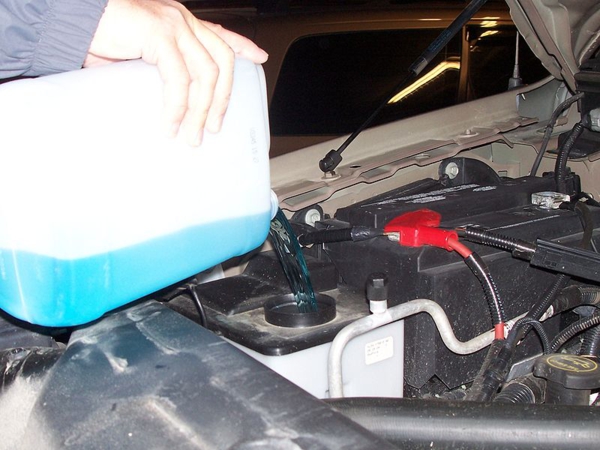The typical image and photo of a car , truck or Sports Utility Vehicle overheating is one of a hood up and boiling radiator one hot summer day. Yet engine and rad overheat episodes can occur to any driver or automobile owner at any time or season of the year given the right driving conditions and poor attention to mechanical upkeep and preventative maintenance.
If Your Engine Overheats Pull Over to The Side of the Road As Soon as Possible:
When an engine overheats , the temperature indicator or “idiot lights’ on your dashboard should hopefully light up and come to life to warn you of impending trouble or even doom. Pull off the road and stop immediately. With any good luck and fortune , your engine has not been damaged. Yet you can bet your auto repair budget that if you ignore your vehicle warning sensors , and pretend like a politician on a loosing streak before an election that all is well and fine , you will have a massive set of problems on your hands in short order. Your auto dash gauges and warning lights are there to “warn” you . Pay heed rather than hoping the lights will just go off and don’t really mean much of anything anyways.

Inspect for Broken Fan Belts:
Once you have pulled over to the side of the road or freeway and are in a safe place away from oncoming or nearby traffic , see if you ( or another helpful more experienced motorist) , can open the hood and look around for a broken fan belt. If the cursory inspection leads you to believe that the fan belt and fan itself are in good working condition the next suspect in order is low coolant ( liquid antifreeze) levels in your radiator.
Don’t Ever Open the Radiator Cap of a Hot Rad:
It is most important , and cannot be overstressed , not to open the radiator cap of any hot engine. You may well be scalded by escaping hot liquids or steam that may whoosh out of open radiator. On top of that the hot stream erupts insidiously. More than one well meaning motorist or bystander has opened the radiator cap off a hot cooling system, waited a brief moment that everything was fine. It all seems fine and safe. Only then did that well meaning person bend over to look. It takes time for an uncapped radiator to erupt once pressure is released with the cap coming off. The hot boiling stream can then erupt out of the radiator hole – scalding the burn victim in a flash. The point to be stressed again is never ever remove the radiator cap off a hot radiator . If nothing else let the engine cool down good or well or if you are in a hurry and have a garden hose handy – spray down the radiator to cool it down.
Inspect Fluid Levels on the Coolant Recovery Reservoir:
Luckily for a number of years now modern cars and trucks what is called a “coolant recovery reservoir”. It will look like a small bottle attached to hose or tube extending from just under that rad cap to the coolant recovery reservoir. On the side of that bottle there will be vertical markings showing hot and cold suggested fluid levels. You may see the words min ( for minimum or lowest ) coolant levels as well as max ( for maximum or highest). Regardless you should see some glycol or antifreeze liquid engine coolant in that canister . If the bottle is totally empty you are no doubt low on coolant fluid.
Adding or Having Ethylene Glycol Antifreeze:
Its a fairly simple matter for a do-it-yourself-er or auto service center to add coolant fluid via that coolant recovery reservoir. Several points of note here. A combination of ethylene glycol coolant and water is added rather than strictly water alone. This is done for two reasons . Firstly a mixture of glycol and water has a higher boiling point than water alone and will allow better dissipation of waste engine heat. Secondly ethylene glycol serves as “antifreeze” preventing freezing and costly engine block damage in cold winter climates. If you are motoring or even vacationing in cold Northern Alberta or the northern United States ensure that a proper glycol mixture ratio is employed. Remember to prepare for the coldest day of winter not the mean average temps. Lastly leave no spills of the glycol on your driveway on the road. The stuff is sweet and deadly to pets and wildlife.
Drivers & Auto Owners Conduct Both Routine Maintenance & Be Knowledgeable of Auto Emergency Diagnostics & Procedures to Get You Back on the Road:
It can be said that with auto maintenance prevention is everything. True its best to maintain your machine to good stead via a regimen of preventative auto care and maintenance. Still you will encounter emergency events and situations in your driving career. For those times its best to know some simple diagnostics as well as what not to do. Remember at the worst – if your engine overheats pull over to the side of the road as soon as possible.
Robert Mc Murray,
The “Big Mac” as McMurray is nicknamed by his friends lives to help people with their routine car car service issues. “Big Mac’ has been around the automotive dealers sales and service industry in Sherwood Park for years and years. No doubt you will hear his discourse at the various donut shops around Edmonton. Yet if Bob has one favorite car now its his classic Mazda RX-7 .

